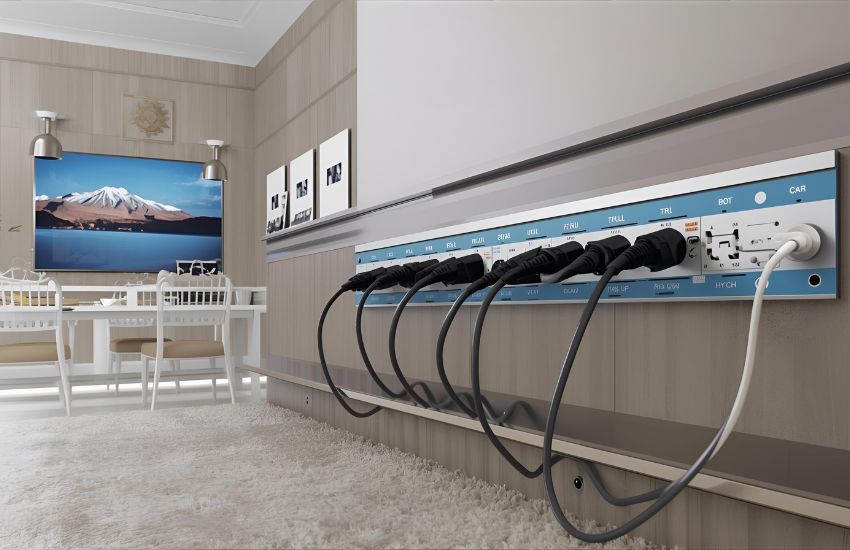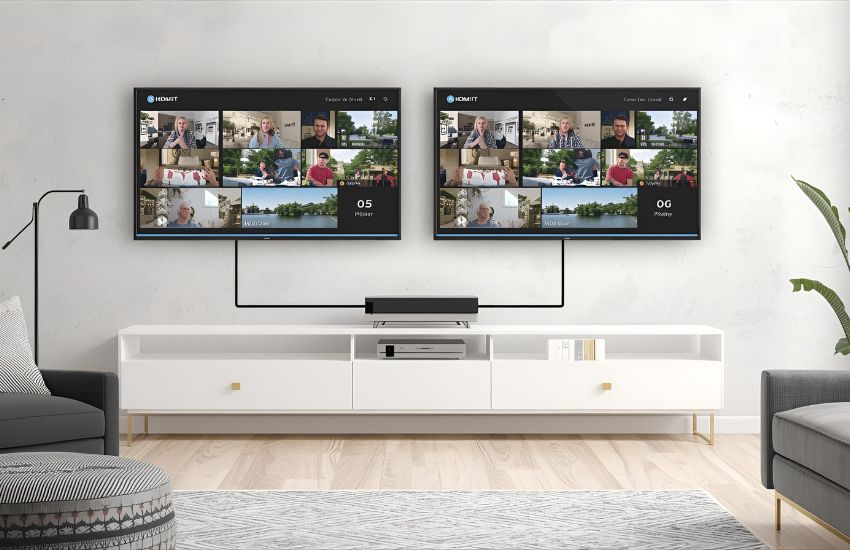Viewing your CCTV cameras on multiple TVs without running long HDMI cables sounds challenging—until you discover how HDMI over powerline technology works. If you’re looking for a clean, efficient way to extend your security camera feed across your property, this modern solution offers an ideal combination of performance and simplicity. By using your home’s existing electrical wiring, HDMI over powerline enables you to transmit high-quality video without the need for additional Ethernet or HDMI cable installations.
To use HDMI over powerline for security cameras on multiple TVs, connect the camera’s HDMI output to a transmitter plugged into a power outlet. Then, plug receivers into outlets near each TV and connect them via HDMI. This setup streams the video feed across your home’s electrical wiring, enabling multi-TV surveillance without running long HDMI cables.
In this guide, you’ll learn how to set up an HDMI over powerline system, including choosing the right extender, cable, and transmitter. You’ll also explore tips for optimizing IR functionality, connecting multiple TVs, and ensuring stable video delivery for your security needs.
Connect HDMI Over Powerline Extender to Multiple TVs Using IR Transmitter

Distributing your security camera feed to multiple TVs throughout your property can greatly improve situational awareness and response time. With an HDMI extender over powerline, you can achieve this efficiently without the hassle of long HDMI cables or complex wireless HDMI configurations. This method uses your building’s existing electrical wiring to carry high-quality video signals from your security camera system to various display points, maintaining both clarity and consistency.
How the Powerline HDMI Extender Setup Works
The basic configuration involves placing a transmitter near the HDMI output of your CCTV or DVR unit. This transmitter and receiver pair communicates through the powerline, sending the HDMI video signal to TVs located elsewhere. When setting up your HDMI over powerline kit, make sure to connect the transmitter to a reliable power outlet and link it to the source via an HDMI cable. The receiver is placed at the TV location, ready to decode and display the signal.
Expanding to Multiple TVs with IR Functionality
To connect security cameras on multiple TVs, look for an HDMI over powerline kit that supports multiple TVs through additional receivers. Some models, such as the IOGEAR HDMI over Powerline Pro, allow you to add receivers to a single pro kit, delivering HD video to several displays. This makes it ideal for large homes, offices, or commercial environments.
Using IR pass-through, you can control your DVR or other HDMI source devices remotely from any connected TV. Simply aim the IR remote at the receiver’s IR sensor, and the signal is transmitted back through the powerline to the source.
Key Considerations for a Stable Setup
- Ensure that both the transmitter and all receivers are connected to the same electrical circuit.
- Avoid plugging the devices into power strips with surge protection, as these may interfere with the signal.
- Choose a reliable powerline adapter that supports high bandwidth for uninterrupted video surveillance.
By integrating this smart and efficient method, you can extend the reach of your security system and monitor every key area from multiple TVs—without additional wiring or signal loss.
See more about…Security Camera with Alarm Light
Use HDMI Splitter, Cable, and Receiver for CCTV Video Multiplexers Setup

When managing security systems across larger properties, delivering a consistent live view of our security cameras to various locations is essential. A reliable way to achieve this is by using a high-quality HDMI splitter in conjunction with professional-grade cabling and receivers to connect your CCTV video multiplexers to multiple monitor displays. This setup allows you to distribute the signal efficiently and view footage across different rooms without degrading video quality.
By using an HDMI splitter, you can connect your HDMI source—such as a Viewtron security camera DVR—to multiple outputs, sending a single stream to various receivers or TVs. Leveraging the property’s electrical wiring, powerline technology takes advantage of existing power outlets to transmit the video signal without the need for new Ethernet runs or long HDMI cables. This method eliminates clutter and maintains a clean installation.
In practical terms, the transmitter and the receiver (or a full powerline transmitter and receiver kit) connect via your internal wiring, delivering reliable signal transmission even to areas far from the DVR. Powerline adapters are designed to handle resolutions up to 1080p, ensuring a crisp and clear feed on all display monitors. If needed, a second receiver can be added to extend output to additional rooms or several TVs.
This configuration proves especially valuable in commercial settings or homes where multiple TV monitors are needed to display a live view from various angles. While wireless HDMI transmitter and receiver options exist, they often suffer from latency or interference. Powerline, on the other hand, ensures more stable performance—particularly when the circuit breaker configuration supports unified connectivity.
Unlike standard HDMI setups, advanced kits such as IOGEAR’s HDMI Over Powerline Pro or a similar extender kit can distribute HD video to multiple displays using only 1 x HDMI Over Powerline Pro receiver1 and 1 x IR for remote command functionality. This not only simplifies your layout but also enhances efficiency by reducing signal loss and ensuring your video and audio at astonishing clarity.
By combining an HDMI splitter, reliable cabling, and the right receivers, you can build a scalable, stable, and professional-grade solution for your video surveillance systems—delivering uninterrupted, real-time monitoring across any room that matters.
See more about…Security Camera App: DVR
Conclusion
Setting up a professional surveillance display using HDMI over powerline technology offers a reliable and streamlined solution for managing multiple monitors across your home or business. Whether you’re using a CCTV quad multiplexer or extending the output from the DVR, this setup ensures smooth and uninterrupted delivery of video and audio to monitor points throughout your space.
Using 1 HDMI splitter or even two HDMI outputs, you can connect a variety of display devices and maintain clarity while accessing a live security camera feed in real time. Systems that come included with the kit, such as a Pro Receiver1 x IR extension, also allow you to control the source remotely—an essential feature for flexible, centralized monitoring.
This method not only supports streaming video and audio but also scales effortlessly with the right components. By combining quality extenders, splitters, and powerline technology, you ensure that your security infrastructure is efficient, expandable, and capable of supporting a multi-display layout with ease.
See more about…4K Security Camera Facial Recognition
Frequently Asked Questions (How to Use HDMI Over Powerline for Security Cameras on Multiple TVs)
How to connect cameras to multiple TVs?
To connect cameras to multiple TVs, use a DVR or NVR with multiple video output ports such as HDMI, VGA, or BNC. Connect each TV to an available port or use an HDMI splitter to send the same feed to multiple displays. Ensure all connections are secure and adjust each TV input source accordingly.
Can I run 2 TVs off 1 HDMI port?
Yes, you can run two TVs off one HDMI port using an HDMI splitter. The splitter duplicates the signal from the source device and sends it to both TVs. However, both displays will show the same image and resolution. To ensure good quality, use a powered HDMI splitter, especially for longer cable distances.
How to view security cameras on all TVs?
Use a DVR/NVR with HDMI or VGA outputs, connect to an HDMI splitter or matrix switch, then run HDMI cables to each TV. Alternatively, use IP cameras with an NVR and stream via Smart TV app or Chromecast/Fire TV; cast the NVR’s RTSP/ONVIF stream. Configure channels, set resolution, and ensure network bandwidth and PoE power.
Can I get access to a CCTV camera on multiple devices?
Yes — you can access a CCTV camera on multiple devices using networked DVR/NVR or IP cameras, cloud services and mobile apps (or RTSP/ONVIF streams). Create separate user accounts with strong passwords, enable firmware updates and encryption. Note bandwidth, simultaneous-stream limits, and licensing may restrict how many devices view at once.
